Mini Special Sapin-Sapin is made extra yummy with macapuno, ube halaya, and sweetened jackfruit. In a fun mini-size, this Filipino sticky rice cake is perfect for get-togethers!
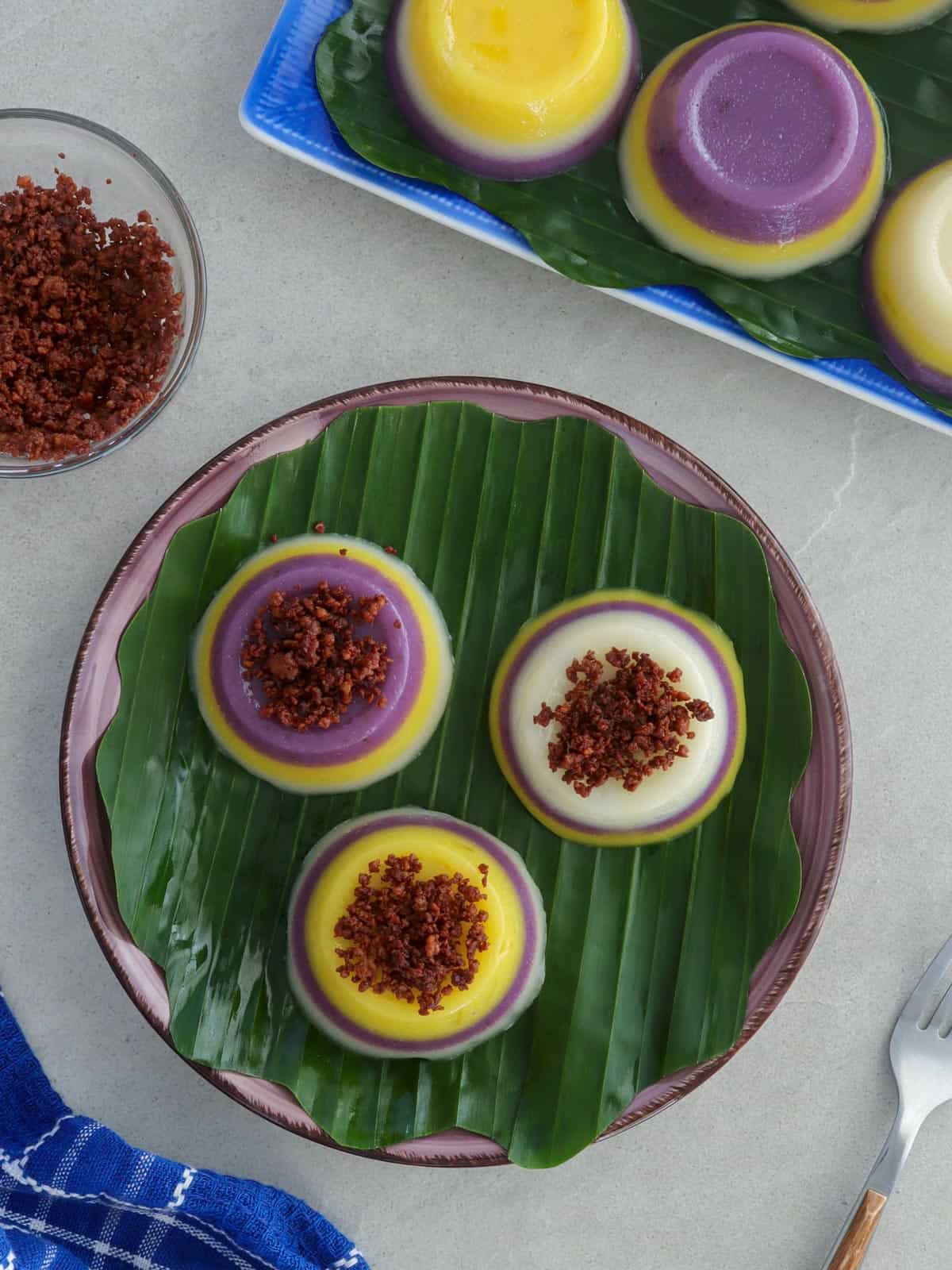
When I asked our Facebook page followers what party recipes they wanted to see, one of the top answers was desserts or, more specifically, kakanin. It's not surprising as we Filipinos love our sweets. 🙂
So today, I am adding to our list of delicacies on the blog, like ube biko, kapit, and pichi-pichi, with a special kakanin. I do have a simple sapin-sapin recipe already up on the blog, but I thought I'd make a more party-worthy version by adding macapuno, purple yam jam, and sweetened jackfruit to the divided batters and steaming the mixture in individual puto molds. The mini layered sticky rice cakes turned out tasty, delicious, super cute, and festive!
Basic batter ingredients
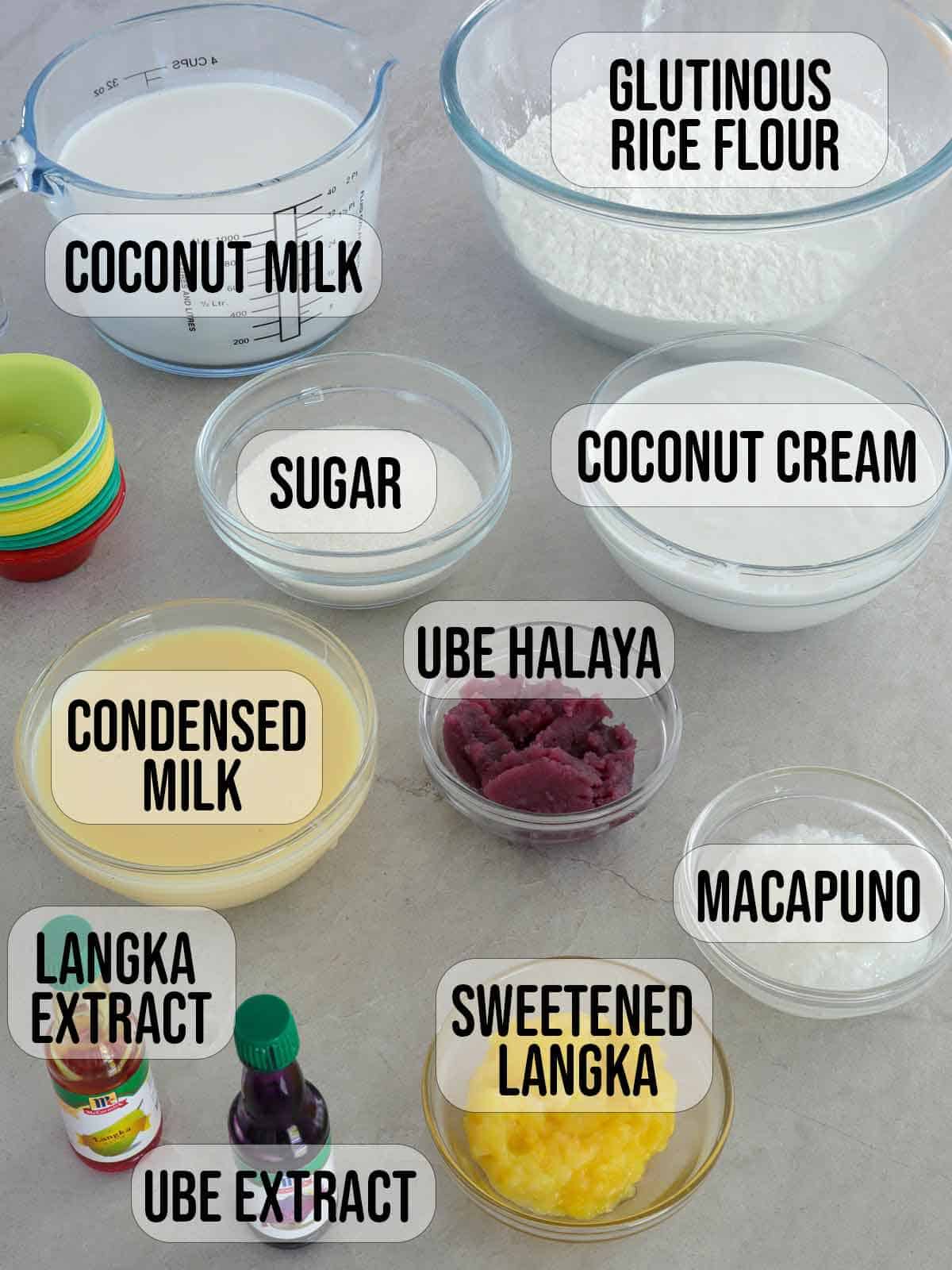
- Coconut cream- kakang gata or first extraction. Due to less water content, it has a more concentrated flavor and creaminess than succeeding extractions. Used for making latik.
- Glutinous rice flour- also known as sticky or sweet rice or locally as malagkit. It gives the kalamay its characteristic chewiness. It is not to be confused with regular rice flour, which has a different texture.
- Coconut milk- usually the second or third extractions. Acts as the liquid in the sticky rice cake.
- Condensed milk- adds creaminess and sweetness.
- Sugar- white granulated sugar is best; add more or less depending on the desired sweetness
Flavor layers
This classic Filipino delicacy has three colorful layers. Add the ingredients below to the batters for an extra yummy treat!
- Purple Layer-¼ cup ube halaya and 3 to 4 drops ube flavor extract.I used store-bought purple yam jam sold in jars. If you prefer fresh, swap it with ¼ cup mashed cooked ube if you prefer fresh.
- Yellow Layer-¼ cup drained and chopped minatamis na langka and 3 to 4 drops langka flavor extract
- White Layer-½ cup drained and chopped macapuno strings
Cooking steps
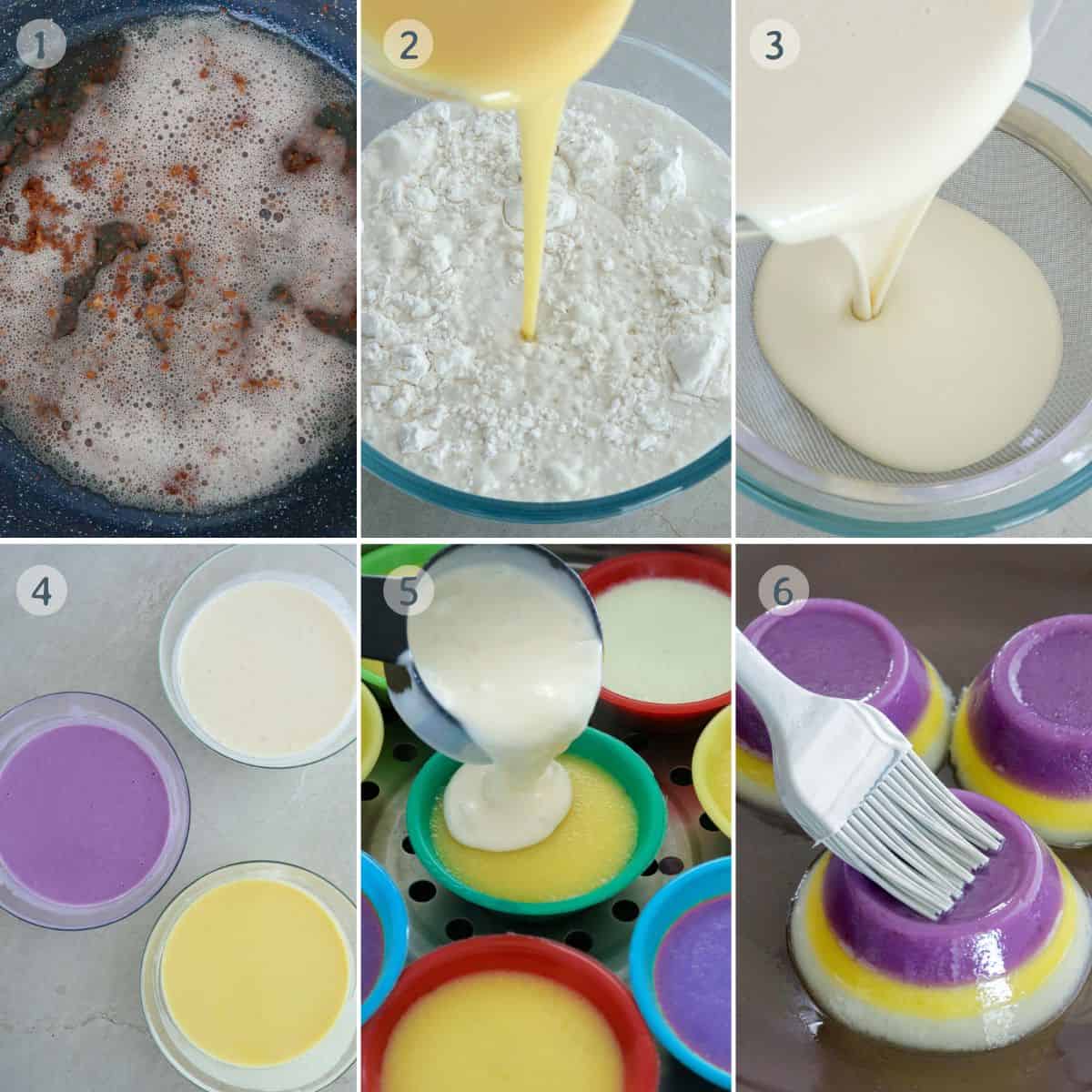
- Make the latik. Cook the coconut cream in a wide pan until the oil separates and solids form. Continue to cook and stir until the curds turn golden brown. Drain the latik from the oil and store it in separate containers until ready to use.
- Make the batter. Combine glutinous rice flour, coconut milk, condensed milk, and sugar in a large bowl and whisk until smooth and well blended.
- Strain the batter. Pass through a fine-mesh sieve or use a cheesecloth to remove any lumps.
- Add flavor. Divide the batter evenly into three separate bowls. Stir in the extracts and add-ins in the individual bowls until well dispersed. and stir to distribute. I use about 3 to 4 drops of each extract; the colors of the tinted batters will be light but will deepen when steamed and cooked.
- Steam the mixture. To keep the steamed cakes from sticking, grease the inner sides and bottom of the molds with coconut oil. Place one flavor in the puto mold and steam until set and a toothpick inserted comes out clean. Place another flavor over the steamed layer and steam until set. Continue until all three layers are steamed.
- Top with latik. Remove the molds from the steamer and let cool. Loosen the sapin-sapin from the mold with a blunt knife, invert on a serving platter, and tap the mold to release. Liberally brush the sticky rice cake with coconut oil and top with latik.
Helpful tip
Alternate the colorful layers for each mini mold for a more festive look.
How to serve and store
S
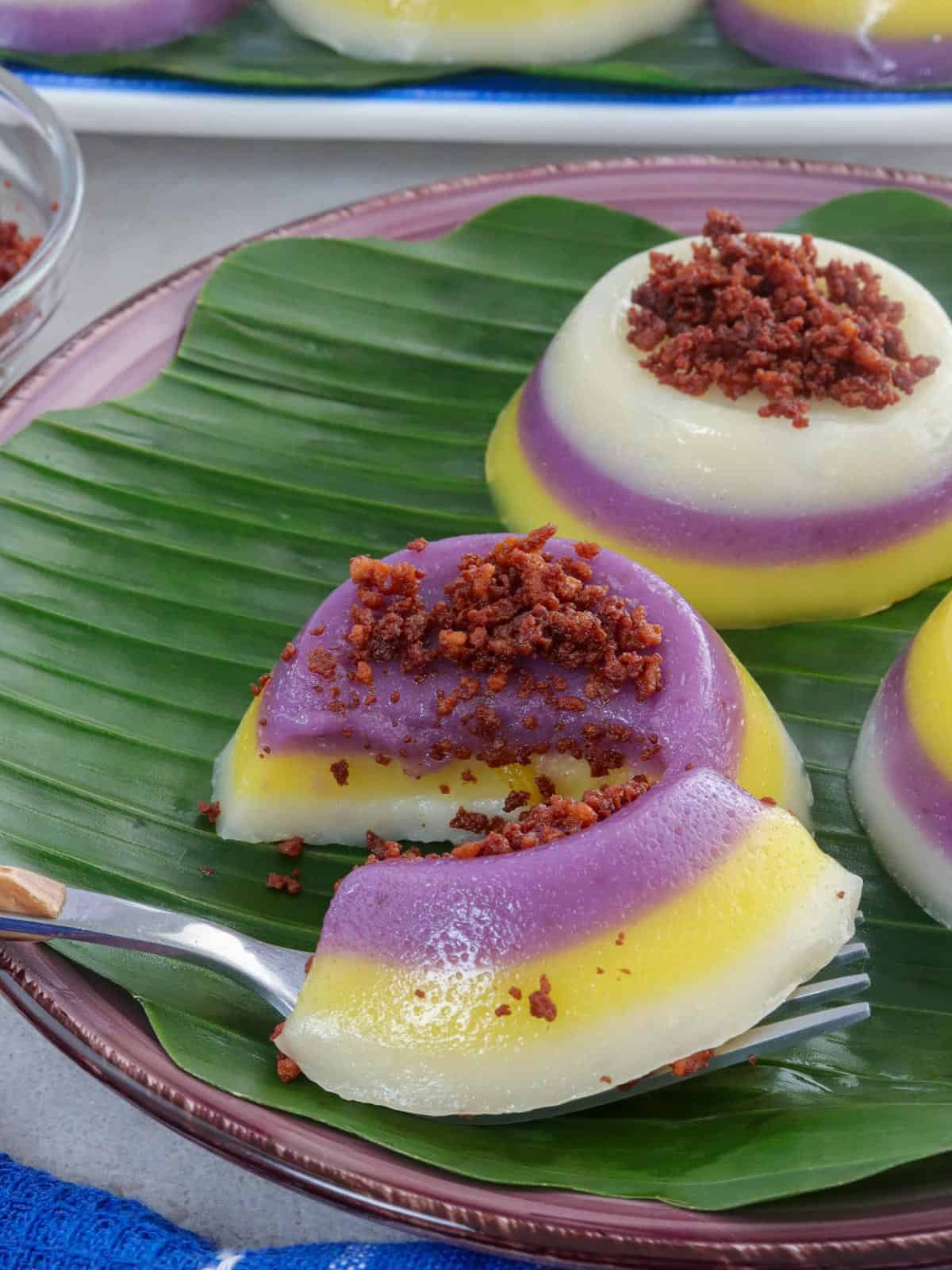
- Add these sticky cakes to your holiday menu! Steaming in small containers does require a bit more work, especially if you're making them for a large crowd, but I'm sure your guests will appreciate how easily they can help themselves to a piece (or two). They're delicious and filling as a midday snack or after-meal dessert.
- Do not store it too long outside refrigeration as it contains coconut milk and will spoil quicker than most foods, especially in warm weather.
- They'd keep in the refrigerator for up to 3 days or in the freezer for up to 3 months. Store in an airtight container to prevent them from drying out.
- The sticky rice cake will harden in the cold. I suggest storing the latik separately and brushing the cake with coconut oil and topping with the latik when about to serve, as the oil tends to form into a film when cold.
- Microwave at 30 to 40-second intervals until warmed through and softened.
R
R
Looking for more delicious kalamay recipes? I've got you covered with kalamay hati and kalamay lansong varieties!
More kakanin recipes
Ingredients
- 1 cup coconut cream
- 3 ½ cups glutinous rice flour
- 2 cans (13.5 ounces each) coconut milk
- 1 can (14 ounces) condensed milk
- ¾ cup sugar
- ¼ cup macapuno strings, drained well and chopped
- ¼ cup ube halaya
- ¼ cup sweetened jackfruit strips, drained well and chopped
- 3 drops ube flavor extract
- 3 drops langka flavor extract
Equipment
- Steamer
- puto molds
Instructions
- In a pan over medium heat, add coconut cream and bring to a boil. Cook, stirring occasionally until liquid starts to thicken.
- Lower heat and continue to cook. As the oil starts to separate and solids begin to form, regularly stir and scrape sides and bottom of the pan to prevent from burning.
- Continue to cook and stir until curds turn golden brown. Drain latik from the oil and store in separate containers until ready to use.
- Lightly grease insides of the puto molds with coconut oil and set aside.
- In a large bowl, combine glutinous rice flour, coconut milk, condensed milk, and sugar. Stir together until sugar is dissolved and the mixture is smooth and well blended.
- Using a fine-mesh sieve, strain batter to remove any lumps.
- Divide the batter evenly into three separate bowls.
- In one bowl, add macapuno and stir to distribute.
- In one bowl, add ube halaya and ube extract and stir until smooth and color is well dispersed.
- In another bowl, add chopped jackfruit and langka extract and stir until color is well dispersed.
- Pour ube-flavored batter into the prepared puto molds. Steam for about 5 minutes or until set and toothpick inserted comes out clean.
- Carefully pour langka-flavored batter over the purple layer. Steam for about 5 minutes or until set and toothpick inserted comes out clean.
- Carefully pour white batter over the yellow layer. Steam for about 5 minutes or until set and toothpick inserted comes out clean.
- Using tongs, remove puto molds from steamer and allow to sapin-sapin to cool completely.
- Run a knife around the sides of the molds to loosen the rice cakes. Gently invert on a serving platter and tap the bottom of the molds to release the sapin-sapin.
- Liberally brush sapin-sapin with coconut oil and top with latik.
Notes
- I use about 3 to 4 drops of each extract; the colors of the tinted batters will be light but will deepen when steamed and cooked.
- I used store-bought purple yam jam sold in jars. Swap it with ¼ cup mashed cooked ube if you prefer fresh.
- Alternate the colorful layers for each mini mold for a more festive look.
Video

Nutrition Information
“This website provides approximate nutrition information for convenience and as a courtesy only. Nutrition data is gathered primarily from the USDA Food Composition Database, whenever available, or otherwise other online calculators.”

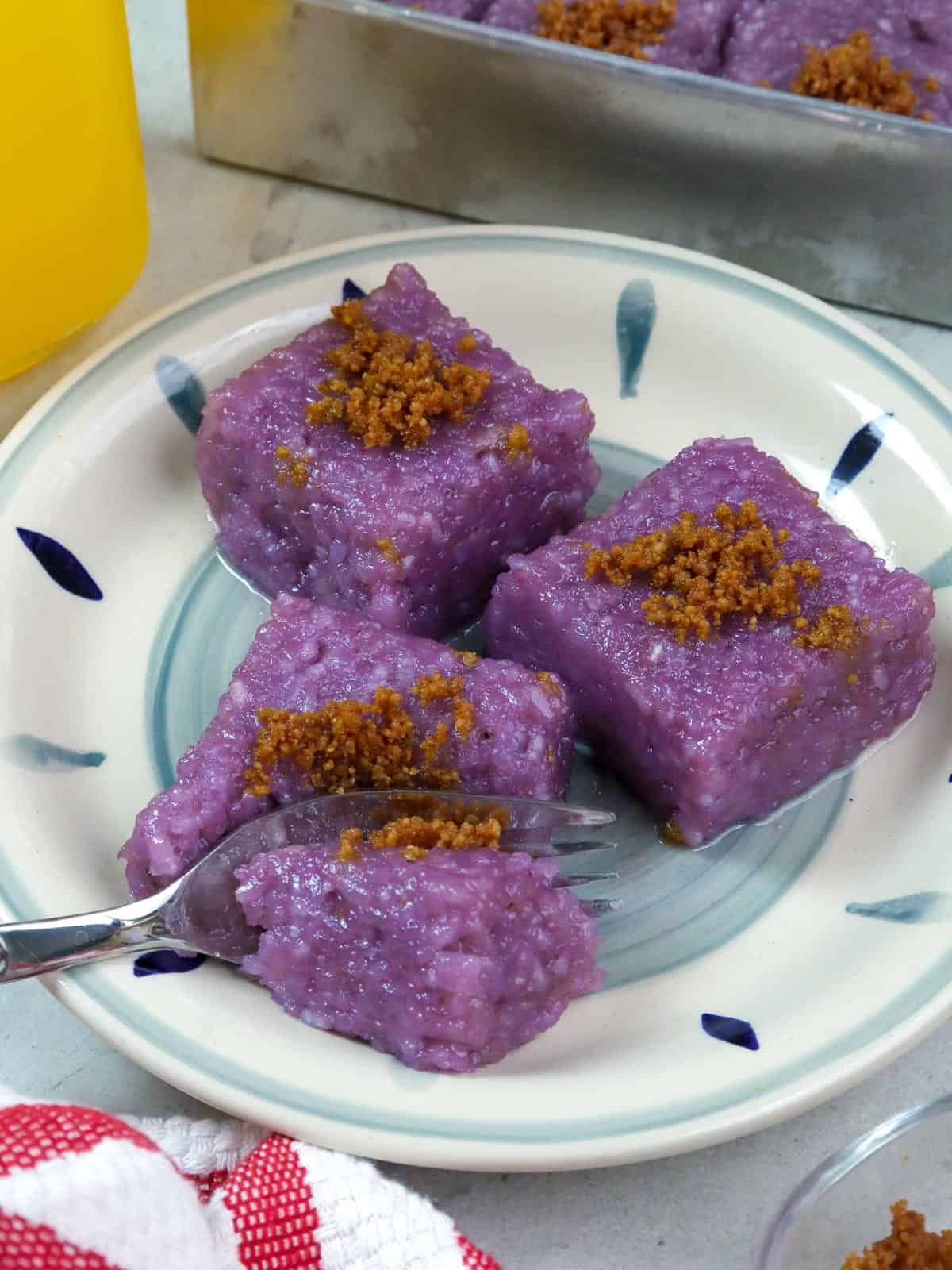
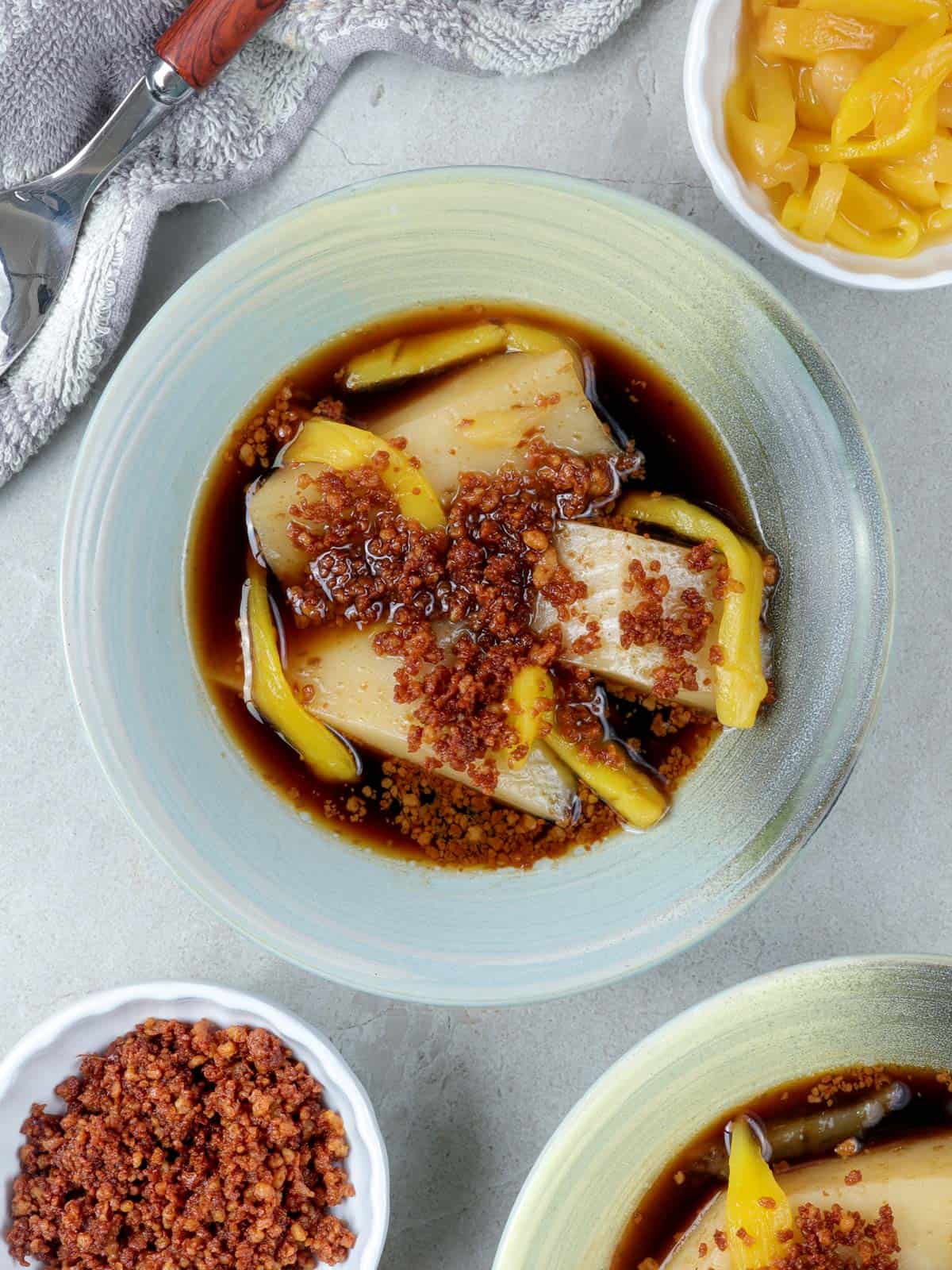
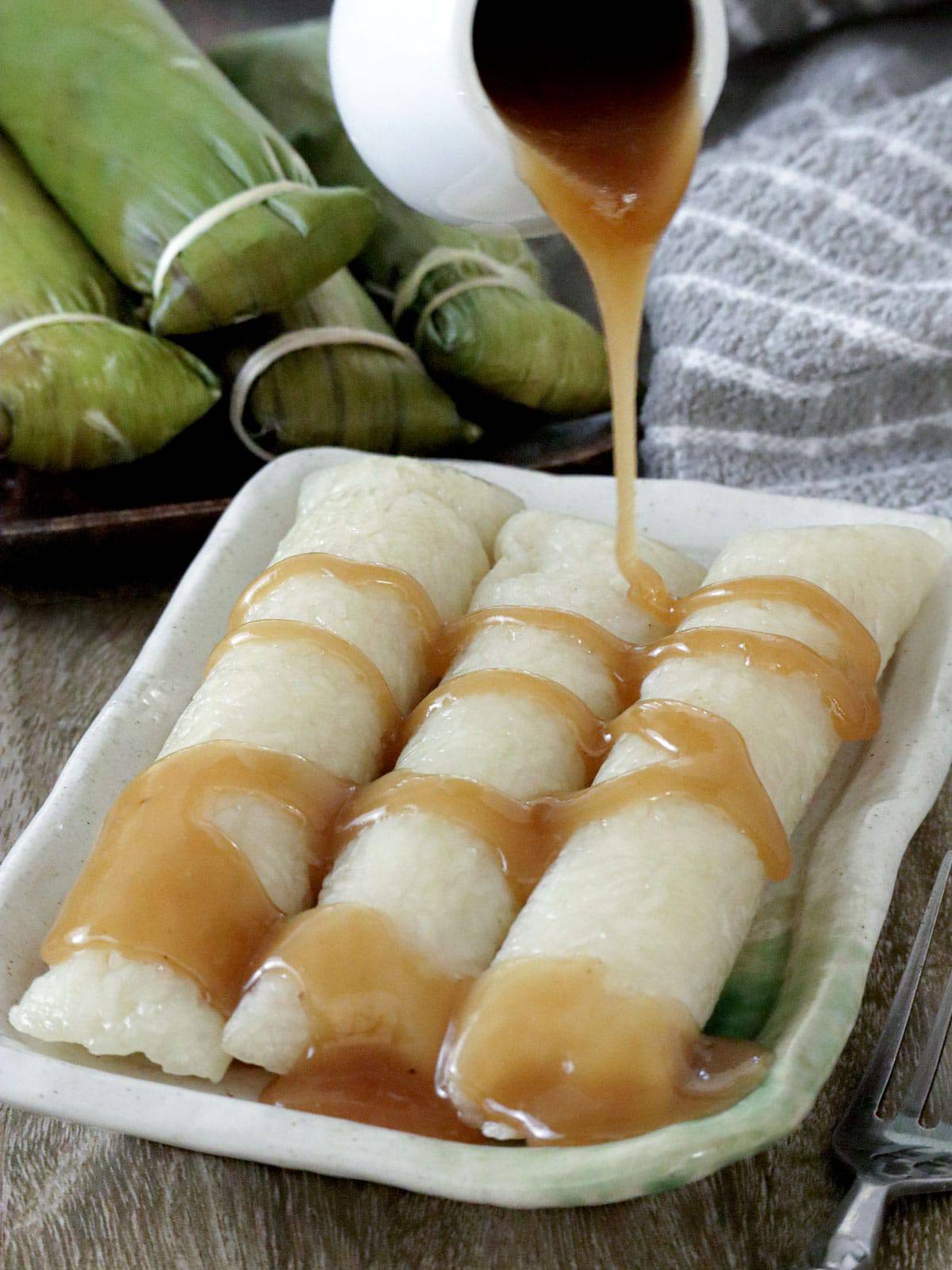
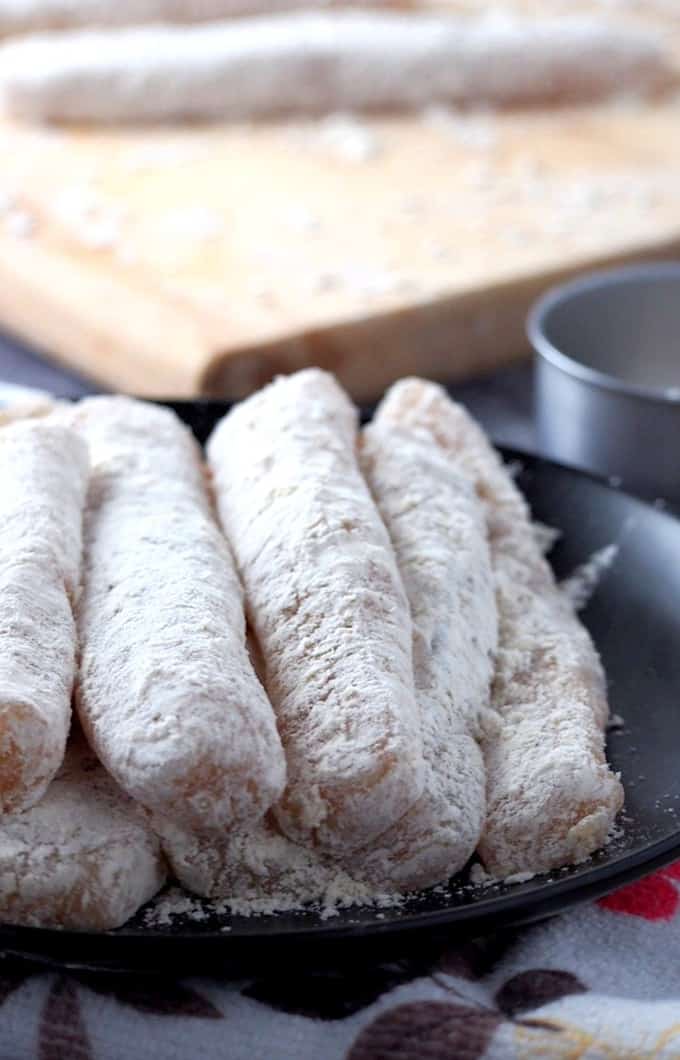
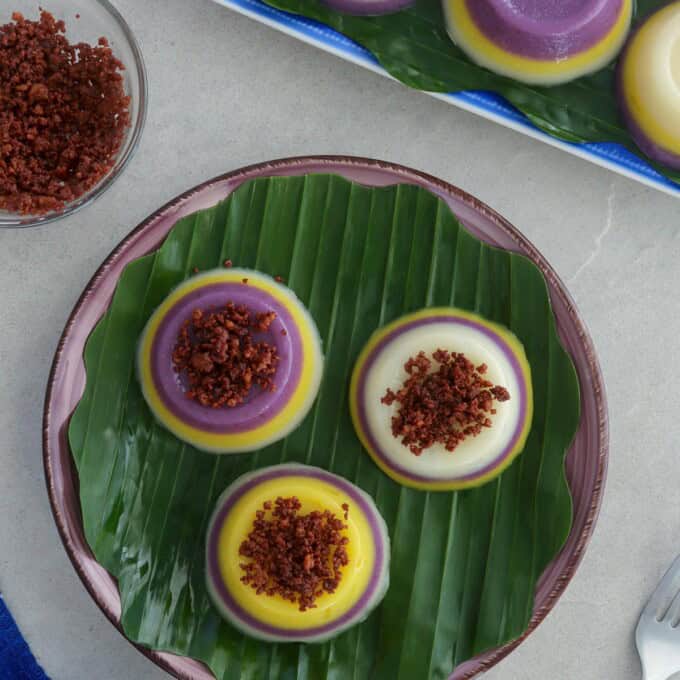
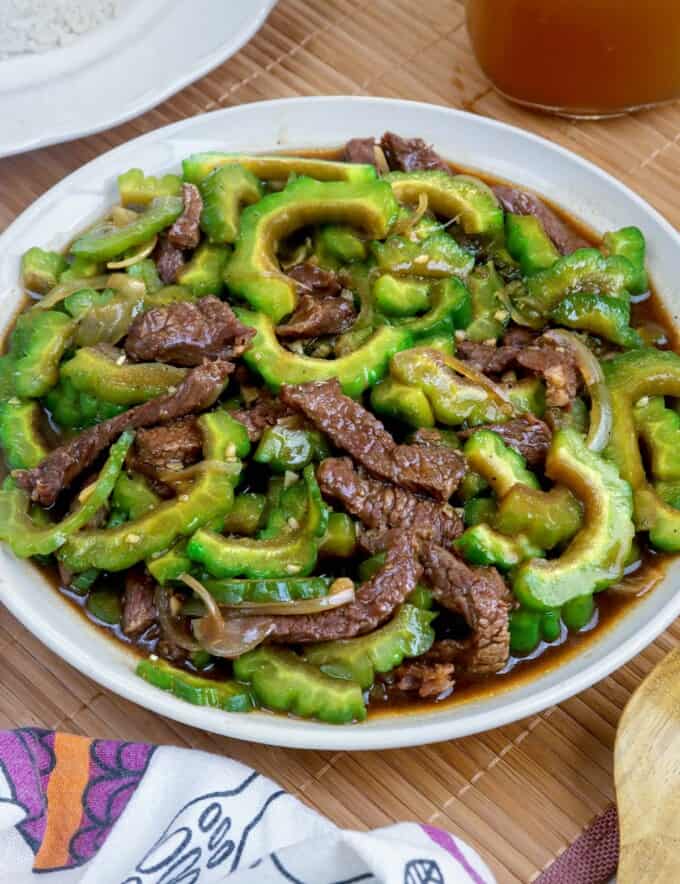

Lani Romie says
Mam good day.gusto ko pong itry ung inyong sapin sapin.if molder po ang gagamitin ko gamit ung ingredients
..how many sapin sapin ang magagawa ko.me order po sa akin sa kasal 200pcs . I will use your recipe kasi masarap po talaga.na try ko na po.dito po ako sa pinas.kaya gagamit ako ng gata from the market...pwede po ba help mo ako if how ko po ma double ung ingredients to make 200pcs..thank you mam for your time..lani from pinas
beatriz says
Hi, I was wondering if I can make these mini sapin sapin in the oven?
Ailyne says
Tried and teated po ang recipe na ito! Iys very tasty and easy and popular among my friends. Thank you for sharing!
Sefty A. Sarmiento says
Good morning. Its so amazing to see your video. Want to start my sapin sapin today but sad to realize that i dont have a steamer. Maybe next week i can buy and start to do it.
Marlene says
Hi,
Where can I buy these molds you are using for the mini sapin sapin. I am located in Toronto and would love to have them when I try this recipe. Thanks a lot.
Marlene
Lalaine Manalo says
Hi, Marlene,
I bought the plastic molds in the Philippines, but you might be able to find some on Amazon.
Jonathan carillo estillore says
Good recipe
Baa says
Salamat sa iyong talento sa pagluluto at pagbabahagi nito sa buong mundo😊 salamat dahil marami akong natutunan. Bawat videos na pipost mo ay aking niluluto din. Salamat po😘
Lalaine Manalo says
Salamat na marami. Pinasaya mo ako sobra 🙂
Dinah catli says
The recipe is very easy and the ingredients is easy to find in the market.
Lalaine Manalo says
Yes, very easy to make 🙂
Sj says
Can I make this a night before the event? Thanks!
Lalaine Manalo says
Yes, you can. 🙂
Cess Agato says
Very affordable and useful recipes.
Lalaine Manalo says
Thank you so much! I am glad you find the recipes helpful!
Josie Lemi says
I really love all your recipes, thank you so much...
Lalaine Manalo says
Thank you so much!
Mila Vicente says
Thank you so much surely my grandkids from WA will enjoy their holidays here in CA. Thank you for sharing. Merry Christmas
Lalaine Manalo says
I hope the grandkids liked the cakes 🙂